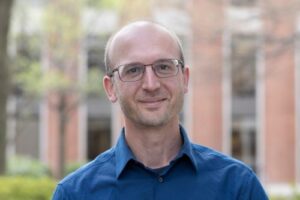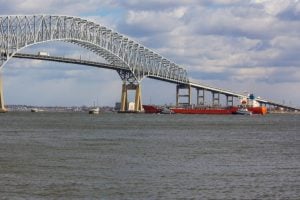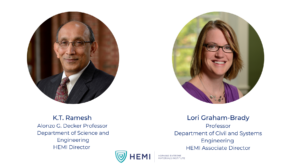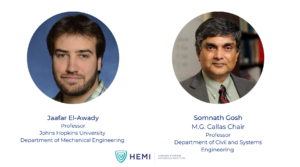One year after the Key Bridge collision in Baltimore, a team of Johns Hopkins students has helped identify which major bridges might be next.
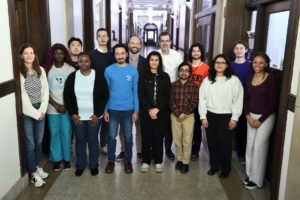
On March 26, 2024, a container ship accidentally struck the Francis Scott Key Bridge in Baltimore, causing a collapse that killed six people. At the time, Michael Shields, a HEMI fellow and associate professor at Johns Hopkins University, described the collision as “a wake-up call.” If a Baltimore landmark like the Key Bridge, which had carried more than 30,000 vehicles across the Patapsco River each day, was so vulnerable to collapse, what did that mean for other American bridges?
With the help a Rapid Response Research grant from the National Science Foundation, Shields immediately got to work forming a team of students to help him assess the country’s bridges and develop new risk models.
Now, a year later, the team has grown to 13 students and two other faculty members. The undergraduate and graduate researchers are responsible for a wide variety of crucial tasks, including analyzing dozens of bridges, writing programs to collect data from the Internet, and building a virtual portal to report the project’s findings. All of this allows the team to consolidate vast amounts of information to calculate the current stresses on major American bridges and pinpoint the most vulnerable ones.
“I’ve guided the direction—steered the ship, if you will—but the students have done a tremendous amount of the work,” Shields says. “They are the lifeblood of the project. Without them, we can’t accomplish what we need to accomplish.”
So far, Shields’s team has identified 19 major American bridges that can expect a collision strong enough to cause catastrophic damage or collapse within the next 500 years, including San Francisco’s iconic Golden Gate Bridge and Maryland’s Chesapeake Bay Bridge. This is dangerously high, especially since bridge design standards stipulate that the risk be closer to once every 10,000 years.
These are findings with serious implications that Shields hopes will inspire real-world change, all thanks to the work of student researchers.
As the nation’s first research university, JHU puts an emphasis on giving students opportunities to get involved in research projects. According to graduate researchers Damir Akchurin and Promit Chakroborty, who manage the undergraduate researchers on Shields’s team, being involved in a project like theirs is a key part of the Hopkins experience. Eighty percent of undergraduate students leave the university having contributed to research.
“At this particular institution, it is kind of inevitable,” Akchurin says. “There are so many opportunities coming up every semester. … The only thing that you need to do is make one small step by reaching out to the professors and asking.”
Adds Chakroborty: “Most research projects require tasks at all levels of expertise. There’s always something that can be found to fit your tastes and your niche.”
Shields’s team meets every Friday afternoon to discuss that week’s findings and assign new tasks. Student researchers of all levels present new breakthroughs in their work.
One of these researchers is junior Diran Jimenez. Despite having little experience, Jimenez says that his ideas and input are always valued by the group.
“I’ve gotten to do a lot of really high-level stuff,” he says. “When I say we shouldn’t do X because of Y, that’s taken into account. That’s real input that you can see the results of in the future. And a lot of the numbers I’ve put together are relied on by everyone, which is really rewarding because I’ve really contributed to this project.”
Senior Natalia Dougan, another undergraduate researcher on the team, echoed Jimenez. She added that being part of a research project gave her new insights into what she wants from her career.
“This experience definitely changed what I thought that I was looking for,” she says. “I had no intention of ever pursuing any research position or academia. …. Now I’m more inclined to want a position where the research process is part of my day-to-day.”
According to Shields, revelations like Dougan’s are common among undergraduate researchers. After all, it happened to him.
“I decided to become a professor and a researcher professionally because of my experiences as an undergraduate researcher,” he says. “When I was an undergraduate, I had an opportunity to spend a couple of years as an intern at Argonne National Laboratory, and that really shaped my career trajectory. … Having those types of opportunities for undergraduate students can really be life-changing. Even for students who may not want to be a researcher long-term, the abilities that they develop to ask probing questions and to think critically are going to be helpful for them.”
This story by Claire Goudreau originally appeared in The Hub.




